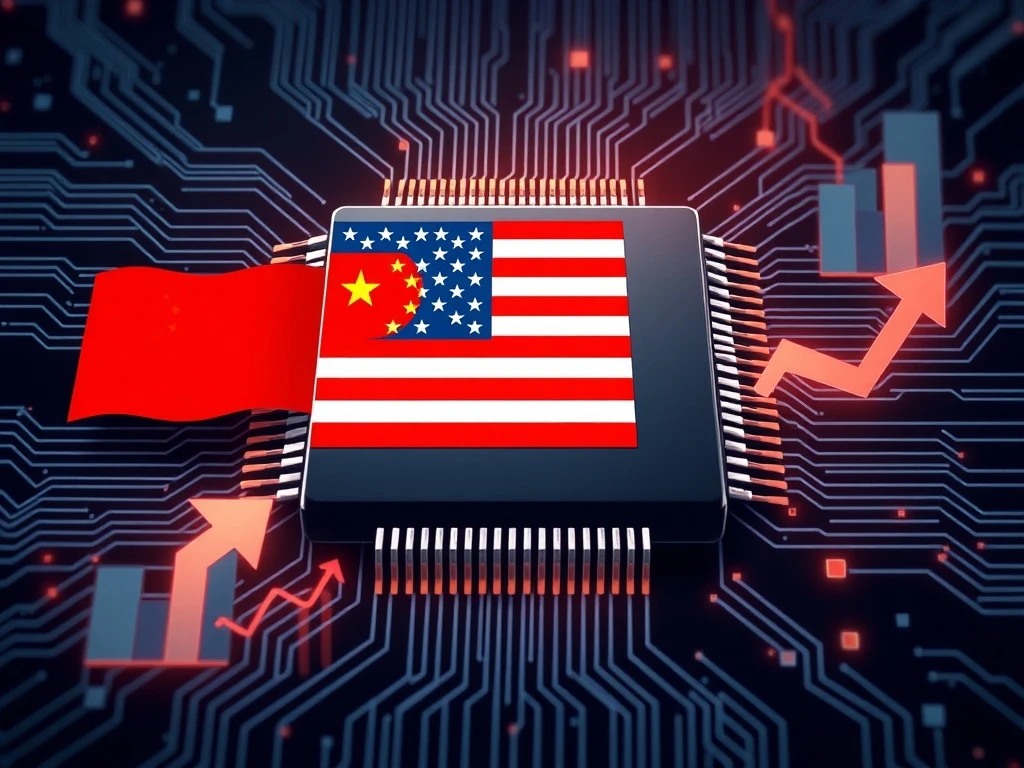A pivotal development is reportedly unfolding in the global technology landscape. Leading semiconductor giants Nvidia and AMD may soon face an unprecedented mandate. Reports suggest they will allocate 15% of their China chip revenues to the U.S. government. This move could reshape financial strategies for these tech powerhouses. Furthermore, it signals a significant shift in U.S.-China economic relations. The reported agreement carries substantial implications for the entire semiconductor industry. Consequently, stakeholders across the globe are closely monitoring this situation.
Unpacking the Reported Mandate on China Chip Revenues
Recent reports indicate a new directive impacting how U.S. tech companies operate in the Chinese market. Specifically, Nvidia and AMD, key players in advanced chip manufacturing, are at the center of this discussion. They reportedly agreed to remit 15% of their earnings from chip sales in China to the U.S. government. This information emerged from sources familiar with the ongoing negotiations. However, official confirmations from either company or the U.S. government remain pending. Therefore, this situation remains dynamic.
Initially, the market reacted with caution. Investors are now evaluating the potential financial impact on both companies. The proposed revenue sharing arrangement targets a significant portion of their highly lucrative Chinese operations. For instance, China represents a crucial market for high-performance computing chips. These chips are essential for AI development and data centers. Thus, any revenue adjustments here are noteworthy. Furthermore, this development underscores increasing government oversight in strategic technology sectors. Analysts suggest this mandate aims to achieve several objectives:
- To fund U.S. domestic semiconductor initiatives.
- To gain leverage in ongoing trade negotiations.
- To control the flow of advanced technology.
Why the US Government Seeks a Share of China Chip Revenues
The U.S. government’s reported demand for a share of China chip revenues stems from a complex geopolitical and economic strategy. Firstly, national security concerns play a significant role. Washington aims to limit China’s access to cutting-edge semiconductor technology. This technology is vital for military applications and AI advancement. Consequently, controlling revenue streams from these sales provides a new mechanism for influence. Secondly, the move could help fund U.S. initiatives aimed at boosting domestic chip production. The CHIPS and Science Act, for example, allocates billions to onshore manufacturing. Revenue from overseas sales could supplement these efforts. Therefore, it presents a potential funding source.
Moreover, this policy could set a precedent for future engagements with strategic industries. The U.S. government might seek similar arrangements in other critical sectors. This approach allows the government to directly benefit from the global success of its domestic companies. Simultaneously, it exerts control over technology proliferation. This strategy reflects a broader trend of increased government intervention in global supply chains. The goal is often to protect national interests and maintain technological superiority. Ultimately, this reported mandate is a direct response to evolving geopolitical realities. It aims to rebalance economic and technological power.
Impact on Nvidia and AMD’s China Chip Revenues
The potential 15% revenue sharing agreement would significantly affect Nvidia and AMD’s financial performance. Both companies derive substantial income from the Chinese market. For example, China is a major consumer of their graphics processing units (GPUs) and central processing units (CPUs). These components power everything from gaming PCs to vast data centers. A 15% reduction in their China chip revenues could translate into hundreds of millions, or even billions, of dollars annually. This would directly impact their profit margins. Consequently, it might necessitate strategic adjustments.
Nvidia, a leader in AI chips, has a particularly strong presence in China. Its A100 and H100 GPUs are highly sought after for AI development. Similarly, AMD’s EPYC processors are critical for enterprise servers. Therefore, any disruption to their Chinese operations is significant. Companies might consider several strategic responses:
- Revisiting pricing strategies for Chinese clients.
- Exploring new markets to diversify revenue streams.
- Increasing focus on domestic U.S. sales and production.
- Negotiating more favorable terms with the U.S. government.
Furthermore, this situation could influence their research and development budgets. Reduced revenue might lead to slower investment in next-generation technologies. Conversely, it could spur innovation aimed at circumventing these restrictions. The long-term effects on their competitive edge remain to be seen. Both companies must carefully navigate this complex new regulatory environment. Their ability to adapt will determine their sustained success in the global market.
Broader Implications for the Global Semiconductor Industry
This reported revenue sharing mandate extends beyond Nvidia and AMD. It sends ripples throughout the entire global semiconductor industry. Firstly, it could prompt other nations to consider similar policies. Governments worldwide are increasingly focused on securing their domestic chip supply chains. They also aim to control critical technologies. This U.S. action might inspire similar protectionist measures. Consequently, global trade dynamics could become even more fragmented. Secondly, it adds another layer of complexity to an already strained supply chain. Manufacturers might face increased regulatory burdens. This could lead to delays and higher costs. Therefore, supply chain resilience becomes paramount.
Moreover, investor sentiment towards the semiconductor sector could shift. Uncertainty regarding future revenue streams might deter investment. Companies heavily reliant on the Chinese market could see their valuations decline. Conversely, firms with diversified geographic exposure might become more attractive. The competitive landscape will also evolve. Chinese domestic chipmakers might receive increased support. This could accelerate their technological advancement. Eventually, they might pose a greater challenge to international players. Ultimately, this reported mandate underscores a new era of geopolitical competition. Technology, especially semiconductors, is at its core. The industry must adapt to these evolving pressures. It is crucial for maintaining global stability.
China’s Potential Response to US Demands on Chip Revenues
China’s reaction to the reported U.S. demand for a share of China chip revenues will be critical. Beijing has consistently emphasized technological self-reliance. This mandate could further accelerate its efforts to develop a robust domestic semiconductor industry. China has already invested heavily in chip manufacturing and design. This new pressure might intensify those investments. The goal is to reduce dependence on foreign technology. Consequently, this could lead to a more competitive domestic market. It might also foster indigenous innovation.
Furthermore, China might consider retaliatory measures. These could range from imposing its own tariffs to implementing new regulations on U.S. companies. Beijing could also strengthen its ‘unreliable entity list.’ This list targets foreign companies deemed harmful to Chinese interests. Such actions would escalate trade tensions between the two economic superpowers. They would also create further uncertainty for businesses operating in both regions. The geopolitical implications are vast. A tit-for-tat escalation could destabilize global trade. It could also fragment technology standards. Therefore, careful diplomacy is essential. Both sides must navigate these complex waters with caution. Any misstep could have far-reaching consequences. The world watches for China’s next move.
Navigating Compliance and Market Volatility
Implementing a 15% revenue sharing policy presents significant compliance challenges for Nvidia and AMD. Firstly, they must establish clear accounting mechanisms. This ensures accurate calculation and remittance of the required percentage. This process could involve complex auditing procedures. Secondly, legal teams must assess the implications for international trade laws. The extraterritorial nature of such a mandate raises questions. It might challenge existing trade agreements. Companies need to understand their legal obligations fully. Non-compliance could lead to severe penalties. Therefore, robust legal counsel is essential.
Moreover, market volatility is a significant concern. News of the reported mandate has already caused fluctuations in stock prices. Continued uncertainty could lead to further instability. Investors will closely monitor company statements and government actions. Businesses must communicate transparently with shareholders. They must also outline their strategies for navigating this new environment. Risk assessment becomes paramount. Companies must identify potential threats and develop contingency plans. This includes diversifying supply chains and customer bases. Ultimately, the ability to adapt quickly will define success. Companies must remain agile in this rapidly changing global landscape. This ensures long-term viability and growth.
The reported mandate for Nvidia and AMD to share 15% of their China chip revenues marks a significant moment. It reflects deepening U.S.-China tech competition. This development will undoubtedly reshape strategies for major semiconductor firms. It also has broader implications for global trade and technological innovation. While details remain fluid, the potential impact is clear. Companies, governments, and investors must prepare for a new era. This era is characterized by increased geopolitical influence over critical technologies. The future of the global chip industry hangs in the balance. Adaptation and strategic foresight will be crucial for all involved parties.
Frequently Asked Questions (FAQs)
Q1: What is the reported mandate regarding China Chip Revenues?
Reports suggest that Nvidia and AMD may be required to give 15% of their revenues from chip sales in China to the U.S. government. This mandate aims to address national security concerns and fund domestic semiconductor initiatives.
Q2: Why is the U.S. government reportedly seeking a share of these revenues?
The U.S. government is reportedly seeking a share of China chip revenues to control the flow of advanced technology to China. This also helps fund U.S. domestic chip production and gain leverage in ongoing trade negotiations.
Q3: How might this mandate impact Nvidia and AMD financially?
A 15% reduction in their China chip revenues could significantly impact Nvidia and AMD’s profit margins. This might necessitate strategic adjustments in pricing, market diversification, and research and development investments.
Q4: What are the broader implications for the global semiconductor industry?
This mandate could lead to increased protectionist measures globally. It might also add complexity to supply chains and shift investor sentiment. Furthermore, it could accelerate China’s domestic chip development efforts.
Q5: How might China respond to this reported U.S. demand?
China could accelerate its efforts towards technological self-reliance. It might also consider retaliatory measures, such as new tariffs or regulations on U.S. companies. This could escalate trade tensions.
Q6: What challenges do companies face in complying with such a mandate?
Companies face challenges in establishing clear accounting mechanisms for revenue sharing. They also need to assess legal implications for international trade laws. Navigating potential market volatility is another significant concern.
























